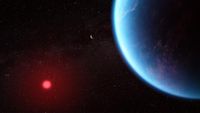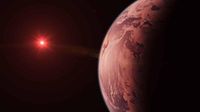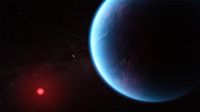In a groundbreaking revelation, astronomers have detected molecules linked to life in the atmosphere of the exoplanet K2-18b, located 124 light-years from Earth. This discovery, announced on April 17, 2025, marks a significant advancement in the search for extraterrestrial life.
K2-18b, first discovered in 2015, has long intrigued scientists due to its position in the "habitable zone" of its star, where conditions may allow for liquid water to exist. This exoplanet is classified as a "Hycean world," a theoretical type that combines a global ocean with a hydrogen-rich atmosphere, potentially creating an environment suitable for life.
Measuring approximately 2.6 times larger than Earth and 8.6 times more massive, K2-18b orbits its star, a cooler red dwarf, in just 33 days. Its unique characteristics have fueled ongoing debates within the scientific community regarding its potential to harbor microbial life.
Previously, studies had detected methane and carbon dioxide in K2-18b's atmosphere, hinting at biological activity. However, the recent findings are particularly remarkable. Researchers have identified chemical signals corresponding to dimethyl sulfide (DMS) and dimethyl disulfide (DMDS) in the atmosphere of K2-18b, compounds that, on Earth, are produced exclusively by living organisms, predominantly marine phytoplankton.
According to Nikku Madhusudhan, an astrophysicist at the University of Cambridge and the lead author of the study published in The Astrophysical Journal Letters, "What we are observing at this stage are signs of possible biological activity outside our solar system. To be frank, I think this is the closest case to a characteristic we can attribute to life."
The detection of DMS and DMDS is significant because these compounds are not known to be produced in large quantities by any geological or chemical processes without the involvement of living organisms. The concentration of DMS detected is estimated at 10 parts per million, a level that is thousands of times higher than what is found on Earth.
Despite the excitement surrounding these findings, scientists urge caution. The chemical signal has reached a significance level of 3 sigma, indicating there is only a 0.3% chance that it could be a random occurrence. However, this does not imply a 99.7% certainty that the signal is caused by life; rather, it suggests a high probability that the signal is genuine. The threshold for a definitive discovery in scientific terms is typically set at 5 sigma, which corresponds to a probability of error of less than 0.00006%.
Moreover, some researchers express skepticism regarding the implications of these findings. For instance, Raymond Pierrehumbert, a professor of planetary physics at the University of Oxford, cautioned that K2-18b's position relative to its star could make it too hot to support life. He stated, "If this planet had water, it would be an infernal furnace, totally uninhabitable."
Additionally, previous claims of water vapor in the atmosphere of K2-18b have faced scrutiny, with experts like Sara Seager, a professor of planetary sciences at MIT, suggesting that other celestial bodies within our solar system, such as Mars and Venus, may have a higher likelihood of supporting life.
Nevertheless, the discovery of DMS and DMDS represents a pivotal moment in the quest for extraterrestrial life, shifting the focus from theoretical possibilities to tangible evidence. The scientific community is eager to conduct further observations using the James Webb Space Telescope to confirm these results and explore the atmospheric composition of K2-18b in greater detail.
As the James Webb Space Telescope continues to collect data, the implications of these findings could reshape our understanding of life's potential throughout the universe. If confirmed, K2-18b could become the leading candidate in the search for an extraterrestrial biosphere, challenging our perceptions of life beyond Earth.
In the grand scheme of the universe, the possibility that life could exist elsewhere, even under conditions vastly different from those on our planet, raises profound questions about our place in the cosmos. If life can arise in diverse environments, it suggests that we may not be unique or alone in the universe.
As researchers delve deeper into the mysteries of K2-18b, they remain committed to a rigorous scientific approach. Nikku Madhusudhan emphasizes the importance of skepticism in science, stating, "It is through repetition and testing that we advance." The journey to uncover the truth about K2-18b and its potential for life is just beginning, and the scientific community is poised to explore this intriguing exoplanet further.
Ultimately, as we stand on the brink of potentially discovering life beyond our solar system, the excitement and curiosity surrounding K2-18b serve as a reminder of humanity's enduring quest to understand the universe and our place within it.





